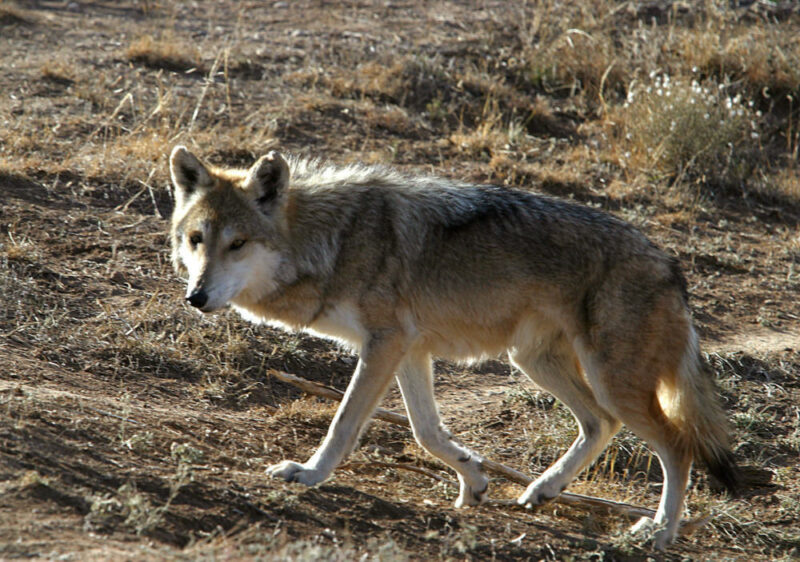
The Mexican gray wolf is an endangered species with about only 350 left in the world.
Courtesy photo Courtesy photo
The latest count for Mexican wolves in Catron and Socorro counties has increased to 114 in the wild. Arizona’s population is 72 for 2020. According to the U.S. Fish and Wildlife’s Interagency Field Team, the wild population of Mexican wolves in the United States saw its fifth consecutive year of growth in 2020. The IFT’s yearly report says the U.S. population of Mexican wolves has increased by 14 percent since last year, raising the total number of wolves in the wild to a minimum of 186 animals.
In 2019, the team documented a minimum of 163 wolves, which was a 24 percent increase from the year before. This population has nearly doubled in size over the last five years.
Brady McGee, U.S. Fish and Wildlife Service Mexican Wolf Recovery Coordinator, said his staff was gratified to see numbers continuing to rise.
“Thanks to our staff’s efforts, we were able to document a minimum of 64 pups surviving in the wild last year,” McGee said. “Pup production and recruitment in the wild population is extremely important to the recovery of this species.”
Among the 2020 findings:
- There were a minimum of 46 packs (including new pairs) documented at the end of 2020: 29 in New Mexico and 17 in Arizona, plus five single wolves in Arizona A wolf pack is defined as two or more wolves that maintain an established territory. By comparison, there were a minimum of 42 packs at the end of 2019.
- A minimum of 124 pups were born in 2020, with at least 64 surviving until the end of the year (a 52 percent survival rate). The average survival of Mexican wolf pups is around 50 percent.
- The IFT recorded a minimum of 20 breeding pairs (12 in New Mexico, eight in Arizona) with pups in 2020.
- There were 96 collared wolves in the wild at the end of the year, which is slightly more than 50 percent of the wild population. These radio collars use satellite technology to accurately record wolf locations on a frequent basis. Biologists on the IFT use this information to gain timely information about wolf behavior in the wild and assist with management of the wild population.
- The IFT documented 29 mortalities in the wild population of Mexican wolves in 2020, which is similar to the mortality rate in 2019 given the growing population.
- This year’s survey represents not only an all-time record number of wolves in the wild but also the most ever breeding pairs, wild packs, pups born in the wild, and pups surviving to the end of the year.
Between November and January, the Interagency Field Team conducted ground counts in Arizona and New Mexico, which concluded with aerial counts in January and February.
In 2020, the IFT placed 20 captive-born pups into seven wild dens (cross-fostering) to boost the genetic diversity in the wild population. The IFT has since captured and collared seven of these pups and will continue efforts in 2021 to document others that may have survived.
With these newly collared pups, the known number of fostered wolves alive is 12.
Clay Crowder, Assistant Director of Arizona Game and Fish’s Wildlife Management Division, Arizona Game and Fish, said this has been the case for a decade.
“This year’s result signals success in the recovery of this element of the Southwest’s biodiversity and offers hope of eventually meeting recovery goals,” Crowder said. “With continued year-over-year increases in the United States, it is important to recognize that Mexico is key to full recovery, and more attention is needed in support of efforts there.”
There still remains resistance from ranchers.
According to a study by the University of Arizona, in addition to economic losses, ranchers face additional management costs due to wolves. Despite compensation programs that help offset losses, resistance to reintroduction remains high among ranchers.
Those ranchers responding to the study reported calf depredation levels ranging from 0 percent to 13 percent. Considering a year with the largest impacts, reported calf depredation rates ranged from 2-13 percent, with an average of 7 percent.
In addition, ranchers not directly affected by the wolves actually had more negative attitudes than those who had suffered livestock losses. In years with low cattle prices, measures used to protect herds from wolves cost more than they yielded, the study found.
The ranchers reported a wide range of spending on measures to reduce losses of livestock to the wolves, including employing range riders, removing the carcasses of dead livestock likely to give the wolf packs a taste for cattle, rotating pastures, shifting the calving season, providing supplemental feed to make it easier to monitor protecting cows and calves and other measures.
On average, those measures cost about $180 per cow, although the range was considerable. In a year with high beef prices, those measures could save money on a per-cow basis. But when beef prices fell, the price of the beef didn’t cover the extra wolf-related costs.
The survey, funded by the Arizona Cattle Growers’ Association, was published on Aug. 28 in the Proceedings of the Vertebrate Pest Conference, a journal for a periodic meeting of predator-killing experts from government and academia.
Michael Robinson of the Center for Biological Diversity argues that wolves have been in the Southwest for thousands of years.
“This study shows that most Arizona cattle owners cannot be persuaded, even with payouts, to accept wolves,” Robinson said. “But wolves have been in the Southwest for eons, long before the livestock industry, and they deserve to be here today. They need tolerance, not unjustified hostility. Without that tolerance, strong regulations have to be in place to ensure their safety.”
Other impediments to Mexican wolf recovery include private trapping on public lands in New Mexico where wolves live, a high number of human-caused mortalities, and a lack of proactive coexistence among some public lands ranchers in wolf country.
The Mexican wolf is the rarest subspecies of gray wolf in North America. It is listed separately from the gray wolf as an endangered subspecies under the federal Endangered Species Act. In 1977, the U.S. Fish and Wildlife Service and many partners initiated efforts to conserve the subspecies by developing a bi-national captive breeding program with the seven remaining Mexican wolves in existence.
Approximately 350 Mexican wolves are currently maintained in more than 55 facilities throughout the United States and Mexico.
Partners in Mexican wolf recovery in the United States include the Service, Arizona Game and Fish Department, New Mexico Department of Game and Fish, USDA Forest Service, USDA APHIS Wildlife Services, White Mountain Apache Tribe, Bureau of Land Management and National Park Service.



















